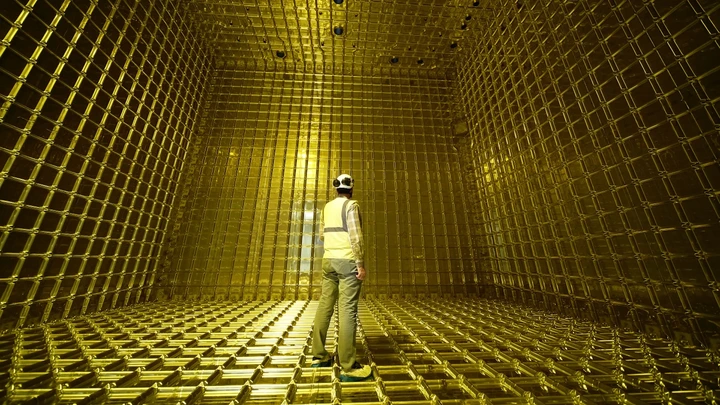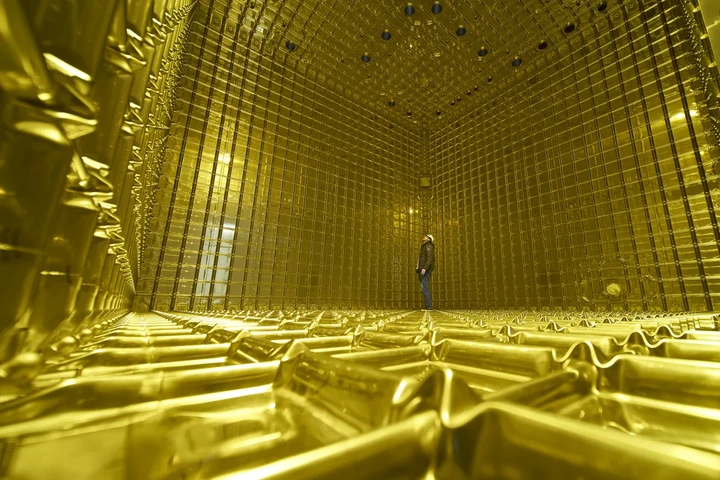Recent studies indicate that a new underground facility named DUNE, designed to accelerate particles over a distance of 800 miles spanning Illinois to South Dakota, may uncover the universe's concealed dimensions.

View pictures in App save up to 80% data.
For over a hundred years, researchers have been intrigued by the idea that unseen, tiny spatial dimensions might be affecting the physics of our well-known three-dimensional universe. However, even after many years of experimental investigations, tangible proof of these additional dimensions remains elusive. Recently, a new study suggests a novel approach to enhance this search: utilizing the forthcoming Deep Underground Neutrino Experiment (DUNE) to explore these concealed dimensions by examining the behavior of neutrinos.
Neutrinos are among the universe's most elusive particles, earning them the nickname "ghost particles." There are three known types — or "flavors" — of neutrinos, each with a mass billions of times smaller than an electron's. These particles are remarkable in their ability to transform — or oscillate — into different flavors as they travel through space, even without interacting with other particles.
Investigating Neutrinos with DUNE
DUNE is a forthcoming neutrino oscillation experiment based in Illinois and South Dakota. "In this experiment, neutrinos are generated by a particle accelerator at Fermilab [in Illinois], travel a distance of 1,300 kilometers [800 miles], and are observed using a massive underground detector in South Dakota," Mehedi Masud, a professor at Chung-Ang University in South Korea and co-author of the study, told Live Science via email.
The experimental configuration is perfect for investigating neutrino oscillations. Neutrinos generated from collisions at Fermilab — mainly muon neutrinos (one of the three types) — will travel through the Earth to arrive at the detector in South Dakota. During their journey, it is anticipated that some of these particles will change into the other two types: electron neutrinos and tau neutrinos.
DUNE scientists aim to explore the evolution of various neutrino flavors throughout their journey, with the goal of addressing key questions in neutrino physics. They seek to understand the hierarchy of neutrino masses, determine the exact parameters that dictate oscillation, and investigate the potential influence of neutrinos in the formation of the matter-antimatter imbalance observed in the universe.

View pictures in App save up to 80% data.
Exploring additional dimensions through neutrino oscillation phenomena.
The study, published in the Journal of High Energy Physics in November, proposes that the enigmatic behavior of neutrinos could be explained if, in addition to the familiar three dimensions of space, there exist extra spatial dimensions on the scale of micrometers (millionths of a meter). While tiny by everyday standards, such dimensions are remarkably large compared with the femtometer (one-quadrillionth of a meter) scales typical of subatomic particles.
"The theory of large extra dimensions, first proposed by Arkani-Hamed, Dimopoulos, and Dvali in 1998, suggests that our familiar three-dimensional space is embedded within a higher-dimensional framework" of four or more dimensions, Masud explained. "The primary motivation for this theory is to address why gravity is vastly weaker than the other fundamental forces in nature. Furthermore, the theory of large extra dimensions offers a potential explanation for the origin of the tiny neutrino masses, a phenomenon that remains unexplained within the Standard Model of particle physics."
According to the authors of the study, the presence of extra dimensions might subtly influence the probabilities of neutrino oscillations in a manner that can be observed by DUNE. These modifications could manifest as a minor reduction in the anticipated oscillation probabilities, along with small oscillatory variations at elevated neutrino energy levels.
Modeling DUNE data to search for additional dimensions
In this study, the authors considered the case of a single additional dimension. The effects of an extra dimension are determined primarily by its size. This dependence creates an opportunity for researchers to investigate the presence of such dimensions by analyzing how neutrinos interact with matter within the detector. The extra dimension influences the oscillation probabilities of neutrinos, which, in turn, can reveal valuable clues about its potential existence and properties.
"Masud mentioned, 'We created simulations of multiple years of neutrino data derived from the DUNE experiment through computational models. By examining the impacts of large extra dimensions on neutrino oscillation probabilities at both low and high energy levels, we were able to statistically evaluate DUNE's capability to limit the possible size of these extra dimensions, presuming they are a part of the natural world.'"
According to the team's analysis, the DUNE experiment has the potential to identify an extra dimension if it measures approximately half a micron (one-millionth of a meter). Currently, DUNE is in the construction phase and is anticipated to start gathering data by 2030. Following several years of operation, the data collected should provide a solid foundation for a thorough examination of the theory surrounding large extra dimensions. The team predicts that the findings from this analysis will be released in about ten years.
Moreover, they believe that integrating data from DUNE with various experimental techniques — including collider experiments and astrophysical or cosmological studies — will improve the precision and accuracy of exploring the characteristics of extra dimensions in the future.
"Masud stated that in the future, integrating insights from various data sources might enhance these upper limits, thereby increasing the likelihood of uncovering large extra dimensions, assuming they are a reality in nature. He added, 'Not only is this an intriguing pathway for new physics, but the possible existence of large extra dimensions could also enable DUNE to achieve more accurate measurements of standard unknowns in neutrino physics, unimpeded by unconsidered effects.'"









